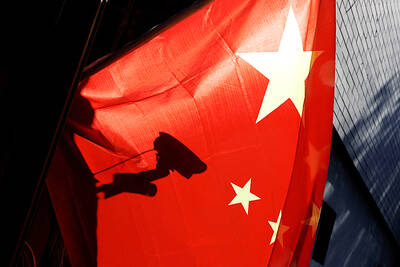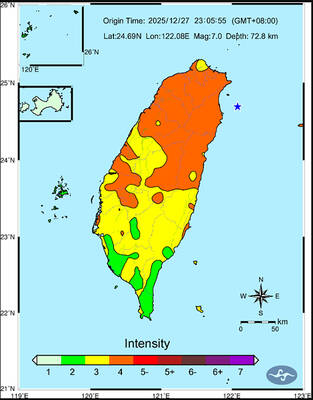North Korea has been testing engines for an intercontinental ballistic missile (ICBM), a US think tank said yesterday, as Pyongyang announced a top military reshuffle that coincided with signs of a looming nuclear test.
The US-Korea Institute at Johns Hopkins University said satellite images of the North’s Sohae rocket launch site suggested one “and maybe more” recent tests on the engine of what is probably the first stage of a road-mobile ICBM called the KN-08.
It was the latest in a series of similar tests — dating back to the middle of last year — on a missile with a targeted range of up to 11,000km, the institute said on its closely followed Web site, 38 North.
“The next technically logical step... would be a flight test of the entire system,” it said.
The successful test of an ICBM capable of reaching the continental US would take the nuclear threat posed by the North to an entirely new level.
Experts believe three nuclear tests have brought the North closer to mastering the miniaturization techniques required to place a nuclear warhead on a missile.
And there are signs it is preparing a fourth test, with multiple analyses of recent satellite images all noting stepped-up activity at the North’s Punggye-ri nuclear test site.
“All these activities are consistent with the view that a [nuclear] test or tests will occur soon,” the Washington-based Institute for Science and International Security said in its latest assessment yesterday.
Missile delivery has often been cited as the main weakness of the North’s nuclear weapons program.
It has yet to test its medium-range Musudan missile with a range of up to 4,000km, let alone an ICBM.
In December 2012, it put a satellite in orbit with a rocket launch that was widely condemned as a disguised ballistic missile test.
That launch marked a significant step forward, but the rocket lacked the re-entry capability required of a functioning ICBM.
Models of the road-mobile KN-08 missile were displayed in North Korean military parades in 2012 and in July last year.
However, several analysts ridiculed what they saw as crude mock-ups, with at least one respected aerospace engineer labeling them technically preposterous and a “big hoax.”
If there is disagreement over how close the North might be to a reliable, working ICBM, there is no doubt that developing one remains a national priority under the leadership of Kim Jong-un.
Pyongyang yesterday announced that Choe Ryong-hae — widely seen as Kim’s effective No. 2 — had been replaced as political chief of the military by Hwang Pyong-so.
“To all intents and purposes, this makes Hwang, who also has close personal ties to Kim Jong-un, the second most powerful man in the country,” said Michael Madden, author and editor of the NK Leadership Watch Web site.
Hwang’s appointment came just days after KCNA reported his promotion to the rank of vice marshall on Monday — a rank shared with Choe and just four others.
It was not immediately clear what had become of Choe, who holds a number of other top positions and was recently appointed vice chairman of the National Defense Commission.

A magnitude 7.0 earthquake struck off Yilan at 11:05pm yesterday, the Central Weather Administration (CWA) said. The epicenter was located at sea, about 32.3km east of Yilan County Hall, at a depth of 72.8km, CWA data showed There were no immediate reports of damage. The intensity of the quake, which gauges the actual effect of a seismic event, measured 4 in Yilan County area on Taiwan’s seven-tier intensity scale, the data showed. It measured 4 in other parts of eastern, northern and central Taiwan as well as Tainan, and 3 in Kaohsiung and Pingtung County, and 2 in Lienchiang and Penghu counties and 1

FOREIGN INTERFERENCE: Beijing would likely intensify public opinion warfare in next year’s local elections to prevent Lai from getting re-elected, the ‘Yomiuri Shimbun’ said Internal documents from a Chinese artificial intelligence (AI) company indicated that China has been using the technology to intervene in foreign elections, including propaganda targeting Taiwan’s local elections next year and presidential elections in 2028, a Japanese newspaper reported yesterday. The Institute of National Security of Vanderbilt University obtained nearly 400 pages of documents from GoLaxy, a company with ties to the Chinese government, and found evidence that it had apparently deployed sophisticated, AI-driven propaganda campaigns in Hong Kong and Taiwan to shape public opinion, the Yomiuri Shimbun reported. GoLaxy provides insights, situation analysis and public opinion-shaping technology by conducting network surveillance

‘POLITICAL GAME’: DPP lawmakers said the motion would not meet the legislative threshold needed, and accused the KMT and the TPP of trivializing the Constitution The Legislative Yuan yesterday approved a motion to initiate impeachment proceedings against President William Lai (賴清德), saying he had undermined Taiwan’s constitutional order and democracy. The motion was approved 61-50 by lawmakers from the main opposition Chinese Nationalist Party (KMT) and the smaller Taiwan People’s Party (TPP), who together hold a legislative majority. Under the motion, a roll call vote for impeachment would be held on May 19 next year, after various hearings are held and Lai is given the chance to defend himself. The move came after Lai on Monday last week did not promulgate an amendment passed by the legislature that

AFTERMATH: The Taipei City Government said it received 39 minor incident reports including gas leaks, water leaks and outages, and a damaged traffic signal A magnitude 7.0 earthquake struck off Taiwan’s northeastern coast late on Saturday, producing only two major aftershocks as of yesterday noon, the Central Weather Administration (CWA) said. The limited aftershocks contrast with last year’s major earthquake in Hualien County, as Saturday’s earthquake occurred at a greater depth in a subduction zone. Saturday’s earthquake struck at 11:05pm, with its hypocenter about 32.3km east of Yilan County Hall, at a depth of 72.8km. Shaking was felt in 17 administrative regions north of Tainan and in eastern Taiwan, reaching intensity level 4 on Taiwan’s seven-tier seismic scale, the CWA said. In Hualien, the